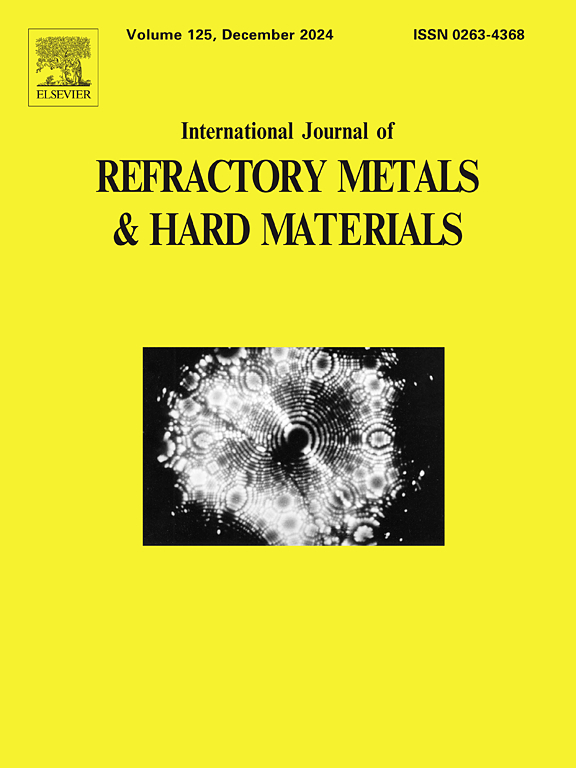激光粉末床熔合含有高含量低熔点金属相的钨合金:致密化行为、显微组织演变及力学性能
IF 4.6
2区 材料科学
Q2 MATERIALS SCIENCE, MULTIDISCIPLINARY
International Journal of Refractory Metals & Hard Materials
Pub Date : 2025-05-19
DOI:10.1016/j.ijrmhm.2025.107238
引用次数: 0
摘要
为了减轻纯钨固有的脆性,通常加入相对低熔点的金属,如镍(Ni)和铁(Fe),以提高合金的韧性。激光增材制造技术为制造结构复杂的钨合金部件提供了一种新的方法。然而,在LAM过程中出现了一个关键的技术挑战:在保持足够的能量输入以实现高熔点钨基体的完全熔化与在强激光热效应下最小化低熔点金属相的蒸发损失之间的根本冲突。采用球磨法制备了高含量低熔点金属相(93 W)的钨合金。系统地研究了激光能量密度对93 W合金致密化、显微组织和力学性能的影响。结果表明,当Ed低于800 J/mm3时,形成了明显的未熔化孔隙。当能量密度在800 J/mm3 ~ 1000 J/mm3之间时,钨颗粒完全熔化,得到93个密度大于95%的W-Ni-Fe试样。但当Ed超过1000 J/mm3时,出现微观裂纹,导致相对密度下降。在900 J/mm3的最佳激光能量密度下,93 W-Ni-Fe合金呈现等轴柱状晶粒,抗压强度和断裂应变分别为2020.6 MPa和30.9%。本研究对LPBF制备的低熔点金属含量高的钨合金的显微组织和力学性能进行了全面分析,为高性能重合金部件的先进制造提供了有价值的见解。本文章由计算机程序翻译,如有差异,请以英文原文为准。
Laser powder bed fusion of tungsten alloy containing a high content of low-melting-point metallic phase: Densification behavior, microstructure evolution, and mechanical properties
To mitigate the inherent brittleness of pure tungsten, strategic additions of relatively low-melting-point metals such as nickel (Ni) and iron (Fe) are typically incorporated to enhance the toughness of alloy. Laser additive manufacturing (LAM) technology presents a novel approach for fabricating complex-structured tungsten alloy components. However, a critical technical challenge emerges during the LAM process: the fundamental conflict between maintaining sufficient energy input to achieve complete melting of the high-melting-point tungsten matrix and minimizing the vaporization loss of low-melting-point metallic phases under intense laser thermal effects. In this study, tungsten alloy with a high content of low-melting-point metallic phases (93 W) was synthesized via ball milling followed by LPBF processing. The effects of laser energy density (Ed) on the densification, microstructure, and mechanical properties of the 93 W alloy were systematically explored. The results demonstrated the formation of significant unmelted pores when Ed was below 800 J/mm3. For energy densities ranging between 800 J/mm3 and 1000 J/mm3, the tungsten particles completely melted, resulting in 93 W-Ni-Fe specimens with densities greater than 95 %. However, when Ed exceeded 1000 J/mm3, microscopic cracks emerged, causing a decline in relative density. At the optimal laser energy density of 900 J/mm3, the 93 W-Ni-Fe alloy exhibited equiaxed columnar grains, with a compressive strength and fracture strain of 2020.6 MPa and 30.9 %, respectively. This study provides a comprehensive analysis of the microstructural and mechanical properties of tungsten alloys with high low-melting-point metal content produced via LPBF, offering valuable insights for the advanced manufacturing of high-performance tungsten heavy alloy components.
求助全文
通过发布文献求助,成功后即可免费获取论文全文。
去求助
来源期刊
CiteScore
7.00
自引率
13.90%
发文量
236
审稿时长
35 days
期刊介绍:
The International Journal of Refractory Metals and Hard Materials (IJRMHM) publishes original research articles concerned with all aspects of refractory metals and hard materials. Refractory metals are defined as metals with melting points higher than 1800 °C. These are tungsten, molybdenum, chromium, tantalum, niobium, hafnium, and rhenium, as well as many compounds and alloys based thereupon. Hard materials that are included in the scope of this journal are defined as materials with hardness values higher than 1000 kg/mm2, primarily intended for applications as manufacturing tools or wear resistant components in mechanical systems. Thus they encompass carbides, nitrides and borides of metals, and related compounds. A special focus of this journal is put on the family of hardmetals, which is also known as cemented tungsten carbide, and cermets which are based on titanium carbide and carbonitrides with or without a metal binder. Ceramics and superhard materials including diamond and cubic boron nitride may also be accepted provided the subject material is presented as hard materials as defined above.

 求助内容:
求助内容: 应助结果提醒方式:
应助结果提醒方式:


